How a flexible economy saved a nation during a period
of unpredictable climate

Excavations at the ancient farm of Hjalmarvik are
providing detailed insights into the ways Icelanders
adapted to changing climatic conditions. (Zach Zorich)
Stefán Ólafsson of the Icelandic
Archaeological Institute
and Céline Dupont Hébert of
Laval University, Quebec City, are
the crew chiefs of a team of archaeologists
with the unglamorous job
of excavating a garbage dump at
Hjalmarvik, an ancient farm on the
northeastern coast of Iceland. Their
approximately 9-by-12-foot excavation
trench sits just outside what
was a sod-walled farmhouse that may
date back to the years shortly after
871, when Iceland was first settled
by groups of Vikings from Norway.
Today, the remains of the house are no
more than a flat spot on the ground
overlooking a small bay a few hundred
yards to the west. The excavation
of the garbage dump, or midden, is
revealing a detailed record of life at the
farm and provides clues to how its residents
handled the severe challenges
the island faced during an extended
period of climatic disruption.
The walls of the trench are striped
with orange peat ash, probably discarded
when the hearth inside the
house was cleaned. Although the crew
has uncovered interesting whalebone
carvings—some decorated with images
and others that were used as gaming
pieces—the most common items
found in the trench are the discarded
bones of the animals eaten by Hjalmarvik's
residents. Laboratory analysis
of the bones has not yet begun,
but at first glance it looks like most of
the food they were eating came from the surrounding ocean.

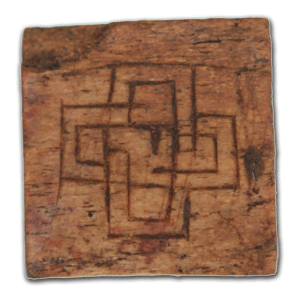
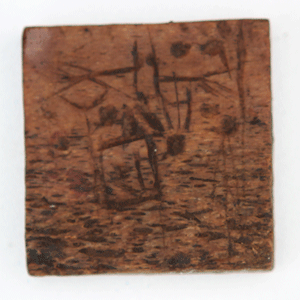
Whalebone carvings are some of
the most intriguing artifacts from
Hjalmarvik. This semicircular carving (top) is a broken disk depicting a
mythological animal. Two sides of
a bone may possibly show a cross
(middle) and writing (bottom). (Zach Zorich)
"We are seeing a lot
of seal and a lot of fish
bones, also some sheep
and a little bit of cow,"
says Hébert, pointing
to small chunks of
bone. A large bone that
may have come from
a beached whale sticks
out of the north wall of the
trench. There are also pockets of
oyster, clam, and periwinkle shells.
Hébert says that until recently Icelanders
ate shellfish only under dire
circumstances, preferring to use it
as bait for fishing.
Near the top of the trench's east
wall, Ólafsson points out
a gray stripe of volcanic
ash that came from the
1477 eruption of a volcanic
fissure named Veidivötn.
This layer provides an
easy way to date the latest
part of the midden. The
ash shows that the site was occupied
throughout a period when Icelanders
faced one of the greatest challenges
to their survival—the Little Ice Age.
Currently, an international group
of archaeologists is excavating sites
across the country in an effort to
understand how Icelanders adapted
to the colder climate. The project
at Hjalmarvik and another excavation
at a fishing station in the west
called Gufuskálar are revealing how
Icelanders changed the way they produced
food so that they could survive
what turned out to be centuries
of long, cold winters.
In 1258, somewhere near the equator,
a massive volcano erupted,
ultimately lowering global
temperatures. According to a study
coauthored by Penn State University
climatologist Michael Mann, average
temperatures in the years after
the eruption dropped between 3.6
and 4.5 degrees F, or about half as
much as temperatures had dropped
at the peak of the last major ice age,
between 18,000 and 12,000 years ago. A group of scientists at the
Institute of Arctic and Alpine
Research in Colorado have
identified the chain
of events that followed
the eruption,
which they believe
led to the long-term
climate change of
the Little Ice Age.
The chain of
events began when volcanoes
threw chemical compounds
called sulfates into
the atmosphere. According
to Gifford Miller, the institute's
associate director
and a professor of geology
at the University of Colorado
Boulder, the process continued as
sulfates reflected sunlight back into
space. The resulting lack of sunlight not only dropped the temperature in
the atmosphere, it made the surface
waters of the ocean colder. The colder
ocean produced more sea ice, which
spread out from the polar ice caps,
cooling waters closer to the equator.
In addition, the white surface of the
ice reflected sunlight, further dropping
temperatures. Miller says that
although the sulfates would have fallen
out of the atmosphere within two to
four years, ocean temperatures would
have taken 20 or 30 years to rebound.
Sulfate levels in ice cores taken from
glaciers in Greenland and Iceland
show that additional eruptions at
volcanoes in the tropics took place in
1268, 1275, and 1285, reinforcing the
cooling effect. Because the effects of
a changing climate are not felt evenly
across the globe, the Little Ice Age
began and ended at different times in
different places. According to Miller,
it started around 1258 in Iceland and
lasted until about 1900.
Even by the standards of a
nation on the edge of the
Arctic Circle, Hjalmarvik is
a cold place. The warm water that comes up from the Caribbean and
keeps southern Iceland relatively
warm doesn't reach this area. Here,
the cold water of the Arctic Ocean
dominates the climate. On a sunny
day in mid-June, the temperature
was about 50 degrees, while it was
about 10 degrees warmer in the capital
city of Reykjavik.
Hjalmarvik seems to have been
just one property within a much larger
estate called Svalbard, which covered
about 58 square miles of land.
Most of Svalbard's wealth came from
growing grass to feed its herds of
livestock, primarily cattle and sheep.
No single farm could have made
use of such a large amount of land,
so smaller subordinate farms and
workstations were built throughout
the property to take advantage of
pastures and other resources that
were far from the main farm. To
date, archaeologists have identified 17 of these. James Woollett, also of
Laval University, is one of the project
leaders looking at sites within
Svalbard's property, including Hjalmarvik,
to understand how the farm
functioned as a whole and how it
changed over time.
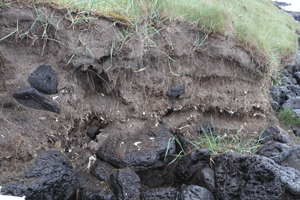
A layer of fish bones roughly three feet thick runs for nearly a mile along the beach at Gufuskálar in western Iceland. The site was
a fish processing station that provided dried cod for a robust international trade dating back to at least the 15th century. (Zach Zorich)
The relationship between Hjalmarvik
and Svalbard is not entirely
clear. The people at Hjalmarvik may
have been independent farmers who
gave a percentage of what they produced
to Svalbard, or they may have
been essentially slave laborers—people
working only for food and shelter
and forbidden by law to marry. In
either case, Svalbard's owner was in a
position to allocate labor to herding
livestock, fishing, and seal hunting.
Once the Little Ice Age began, the
farmers were faced with shorter growing
seasons, which meant that they
had to reduce the size of their herds.
The colder climate forced the people living at Svalbard to change how they
were producing their food.
In 1988 Woollett was part of a
team that excavated the midden at
Svalbard. What that dig, as well as
excavations at other sites on Svalbard's
property, revealed is that the
people at the farm ate mostly mutton,
beef, and a little pork in the middle
of the thirteenth century, before the
climate got colder. Woollett believes
that the farmers at Svalbard figured
out an ingenious strategy to adapt to
the colder and less predictable climate
as the Little Ice Age set in.

A few of many fish-drying huts sit a few hundred yards from the beach at Gufuskálar. The huts were made of lava rock, and
provided a place to store dried cod before it was loaded onto ships and taken to Europe. (Zach Zorich)
During the coldest winters, sea ice
would have covered the bays at Svalbard.
This usually meant a short summer
with little time to grow grass to
feed sheep, but the ice also brought a
food resource with it—seals. According
to Woollett, the excavations
around Svalbard reveal that after the Little Ice Age began, the amount of
seal and fish bone in the middens
dramatically increases, demonstrating
that these animals were an important
part of the diet. The people of
Svalbard could also rely on getting a
certain amount of food by fishing and
by butchering beached whales.
At the same time, the farmers at
Svalbard changed their herding strategy.
The farm would have kept a few
cows for dairying and a few horses for
transportation, but almost all of the
animals raised at Svalbard were sheep.
According to Woollett, this was a good
approach because sheep are hardier
and require less fodder than pigs and
cattle. The pastures in northeastern
Iceland aren't as productive as those in
continental Europe, so the strategy at
Svalbard seems to have been to raise a relatively small number of sheep on
a large amount of land. "The land is
pretty crappy, but there is a lot of it,"
says Woollett, adding, "they're not
producing what you want to eat if you
are an elite [i.e., beef], but it is a predictable
and durable system." A similar
system persisted for centuries. Even
after farmers began to use tractors in
the early to mid-twentieth century and
were making money from tourists who
wanted to fish in their rivers, sheep
herding remained the agricultural
focus of the area's farms.

The fishermen's boats were dragged onto the beach at specific locations at the
site of Gufuskálar. Lava rock on the beach shows evidence of the grooves created
when boats were hauled ashore. (Zach Zorich)
Climate was not the only factor
affecting the Icelanders'
survival. Even after the Little
Ice Age had set in, the country was
becoming more connected to Europe
through trade as word spread about
Iceland's rich fishing grounds. Along the coast, then, as now, the warm-water
Irminger Current and the cold-water
East Greenland Current meet, causing
nutrients from the deep ocean to rise
closer to the surface, where fish feed.
The water temperature and relatively
shallow continental shelf around western
Iceland also make it a perfect area
for cod spawning. Fishing had started as
a way for farmers to feed their families
and trade with their neighbors, but,
ultimately, it transformed into the lucrative
international trade in dried cod.
Historical documents record that by
1410 English ships were coming to Iceland
both to buy dried cod and to fish
these waters. The English were soon
followed by traders from across Europe,
including members of the Hanseatic
League, an association of mostly German
merchants who controlled much
of the trade in northern Europe.
Evidence of the cod trade comes
from the site of Gufuskálar at the end
of the Snaefelsnes peninsula in western
Iceland. There, Lilja PálsdÓttir of
the Icelandic Archaeological Institute
is leading a project to uncover the
remains of an enormous fish-processing
site. Walking along the shoreline, PálsdÓttir points out a few places
where grooves were worn into the
rock from years of having boat keels
dragged over them.
After hauling their boats on
shore, fishermen would unload their
catch and take the fish to be cleaned
at workstations just off the rocky shoreline. The fish were gutted and
their heads and part of their spines
removed. The discarded bones of
hundreds of years of activity now
form a midden about three feet
thick that extends for nearly a mile
along the beach, testifying to the
number of cod that were caught
here. The fish would then have
been taken back down to the beach,
where they were washed and laid flat
to dry on tables made of stacked lava
rocks. After the fish were dried, they
were piled inside a group of small
huts, also made of lava rock, that sit
a few hundred yards from the beach,
to await transport. In 2009, when
she first surveyed the drying huts,
PálsdÓttir identified 154 of them,
and takes them to be another indicator
of how vast the fishing enterprise
was and the impact it had on Iceland's
economy.
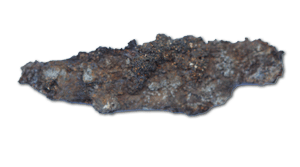
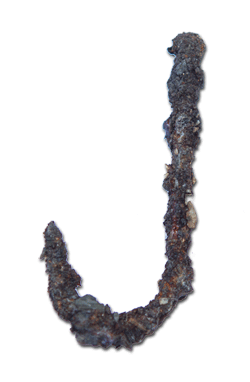
An iron knife blade
(top) and fishhook
(bottom) recovered from
Gufuskálar were some
of the tools of the
fishermen's trade. Until
the 20th century, people
fished from row boats
using only line with
baited hooks. (Zach Zorich)
"The cod trade changed the focus
from inland farming to fishing," says
PálsdÓttir. Gufuskálar was on one
of many tracts of land owned by the Catholic Church, and it is likely,
according to PálsdÓttir, that the fishermen
were providing their catch to
the Church as rent for the pastureland
where they grazed their sheep.
In exchange for the fish, the Icelanders
received some of the essential
goods that they had trouble producing
themselves—iron, grain, and
lumber—as well as luxury goods from
Europe, PálsdÓttir thinks. Cod, then,
had become an important linchpin in
Iceland's economic survival.
In 1450, a volcano called Kuwae
erupted in the South Pacific, again
cooling the climate. Within 50 years,
Kuwae was followed by three eruptions
at other, so-far-unknown, locations,
which compounded the cooling
effect. In addition, 1450 happened to
be the beginning point of a 90-yearlong
period of low solar activity called
the Spörer Minimum. This combination
of events led to one of the coldest
phases of the Little Ice Age.
During periods when the climate
was too cold for grass to grow and
sheep were dying off, marine fish gave
the Icelanders something to eat and
something to trade for grain from
Europe. One of the worst periods in
Iceland's history occurred after the
1783 eruption at the fissures of Laki
in the south-central part of the country.
That eruption cooled the climate
at a time when the country had not
yet recovered from the 1707 smallpox
epidemic that had killed as much
as one-third of its population. "The
agriculture just collapses, and cod
becomes very, very important," says
PálsdÓttir. "It's the main thing that
keeps people alive."
Fishing is still an important part of
Iceland's economy, and the industry
is carefully managed to prevent overfishing.
In 2011, more than $2 billion
of marine products were exported.
But now the country is faced with
an entirely different type of climate
change: The weather is warm and getting
warmer.
Zach Zorich is a senior editor at ARCHAEOLOGY.

